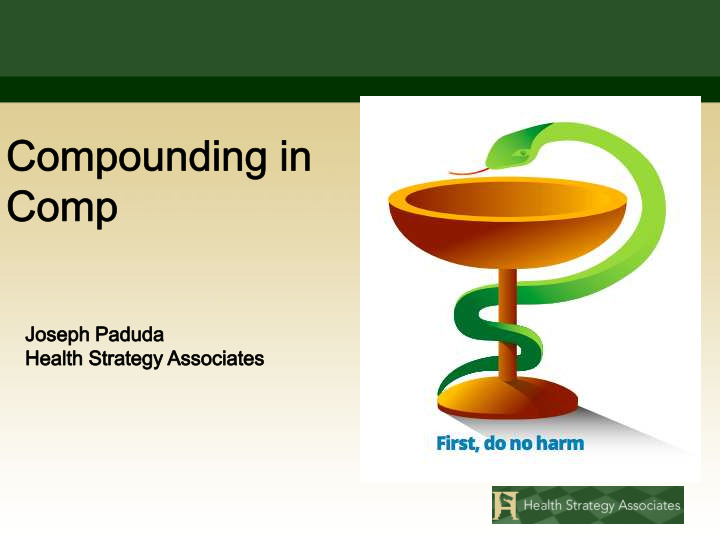



The Physician-Patient-Pharmacist Triad Physician examines and diagnoses patient’s complaint, and if appropriate prescribes a drug or treatment. No conflict of interest if physician does not profit from prescription. Patient, free of any undue influence by the prescriber, takes prescription to the pharmacist of his/her choice. Pharmacist fulfills prescription. As s/he has not influenced the prescriber’s choice of drug, is also free of any conflict of interest. 11/30/2017 Preliminary Report of an Upcoming CompPharma White Paper: Not for Distribution 2
What Are Compound Drugs? “ Compounding ” is the preparation, mixing, assembling, packaging, or labeling of a drug Typically used for patients with allergies, specific medical conditions/limitations, and children
USP standards Sterile Preparation (795) Non-sterile Preparation (797)
Types of Compounding Examples • sterile compounding of intravenous drugs for in-patient use • compounding of oral preparations for individuals with allergies to ingredients found in manufactured drugs • compounding of custom dosage forms of medications for patients with special needs 5
Problems: Not Proven Effective • Very little testing or oversight • Not FDA approved • Efficacy of drugs through dermal absorption has not been proven Accessed on March 2014. http://training.seer.cancer.gov/melanoma/anatomy
Problems: Not Medically Necessary FDA approved drugs in pill form are typically available, therefore there’s no reason for the • potentially dangerous, • possibly duplicative, • likely expensive and • probably ineffective topical cream.
Problems: Duplicative & Risky Many compounds contain multiple, similar drugs Compounds have led to deaths and illnesses in some cases (Massachusetts case)
Problems: Expensive • Can cost thousands of dollars • Many states have no effective controls or limits on • Prices or • Number of scripts • Compounding industry adapts to many controls INSTANTLY
Questionable Marketing Practices • Direct to consumer advertising • 1099 sales forces • Physician dispensing • “ Detailing ” prescribers • Result: Egregious profits for many. 11/30/2017 Preliminary Report of an Upcoming CompPharma White Paper: Not for 10 Distribution
Mass Marketing http://www.comppharma.com/CompoundDrugResearch.pdf
Examples Houston, Texas: 4 residents were indicted on charges of conspiracy to commit wire fraud, and unlawfully distributing a controlled substance on 12/8/2015. The scheme ultimately resulted in $17,000,000 in fraudulent healthcare claims over a two-year time period. 11/30/2017 12
Florida New Port Richey, FL: co-conspirators allegedly used A to Z Pharmacy Inc., located in New Port Richey, as well as several Miami-area pharmacies. The pharmacies allegedly submitted $633 million in claims for compounded prescriptions and received $157 million in payment.
Florida Tampa, FL: the United States is seeking a money judgment in the amount of at least $5.3 million as proceeds of the conspiracy and health care fraud offenses and forfeiture of a 2015 BMW in an indictment charging Dr. Anthony Baldizzi (52, Tierra Verde) with one count of conspiracy to defraud the United States, twenty-one counts of health care fraud, one count of money laundering, one count of making a false statement, and one count of receiving illegal kickbacks.
In Workers’ Compensation… The primary issue is “ topicals ” – creams, gels, or ointments that are applied to the skin.
Compounding Kits The use of compounding kits (sometimes called FDA Convenience Kits) continues to increase. These kits are intended for topical use in the workers’ compensation population, with various indications and may contain ingredients such as analgesics, muscle relaxants, steroids, anti-inflammatories or other drugs. These compounding kits are marketed to compounding pharmacies as a convenience to the compounding staff to save time, decrease waste and improve compliance, reproducibility and accuracy. • 11/30/2017 Preliminary Report of an Upcoming CompPharma White Paper: Not for Distribution 16
Compounding Kits (cont.) Typically, these products are submitted by the dispensing pharmacy for processing through the PBM using the product NDC, rather than as a compound. This action bypasses the pharmacy-benefits managers and many state workers’ compensation requirements for review of appropriateness of compounds. The use of compound kits by physicians likewise bypasses compound and other safety edits in place at the pharmacy. • 11/30/2017 Preliminary Report of an Upcoming CompPharma White Paper: Not for Distribution 17
FDA Regulation of Compounding Compounding Quality Act, Title I of the Drug Quality and Security Act (DQSA) - Section 503A describes the conditions under which certain compounded human drug products are entitled to exemptions from three sections of the FDCA requiring: Compliance with current good manufacturing practices (CGMP) (section 501(a)(2)(B)); Labeling with adequate directions for use (section 502(f)(1)); and FDA approval prior to marketing (section 505). • 11/30/2017 Preliminary Report of an Upcoming CompPharma White Paper: Not for Distribution 18
Potential Solutions - Reimbursement limits • Per script • Per ingredient • Caps on number of ingredients, total cost per script • Ohio’s fix
Potential Solutions: Retrospective Review Review for medical necessity post-dispensing, particularly since compounds are rarely determined necessary Same standards as pre-authorization
Potential Solutions: Pre Authorization • All compounds must be pre-authorized by the payer • Standard is compliance with Evidence-Based Clinical Guidelines (per state) • Approval only if prescriber documents patient • Fails treatment with oral medications, • Is allergic to oral medication ingredients, and/or • Cannot swallow.
Potential Solutions: Employer direction • Employer can direct patients to network pharmacies • Employers not required to reimburse non- network pharmacies
Sources • CompPharma.com • https://comppharma.com/wp- content/uploads/2016/09/CompPharmaCompou ndsinComp2017.pdf • Contact information Joe Paduda Jpaduda@HealthStrategyAssoc.com 203/314-2632
Recommend
More recommend